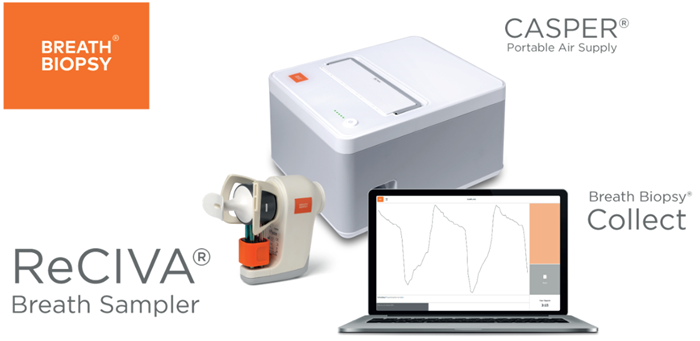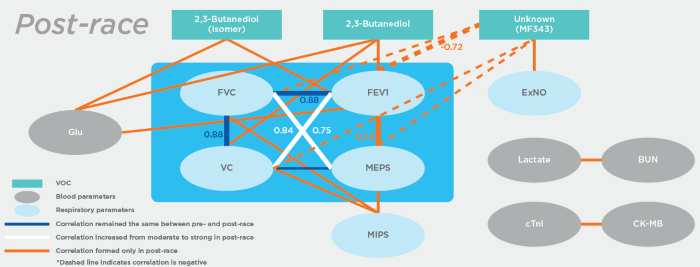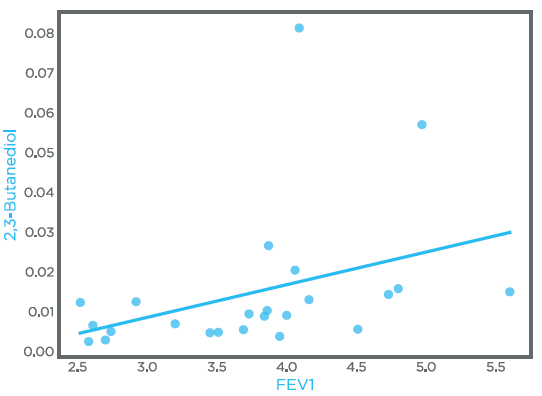This article is based on a poster originally authored by Hsuan Chou, Amy Craster, Kayleigh Arthur, Billy Boyle, Matt Kerr, Eli F. Kelley, Glenn M. Stewart, Courtney M. Wheatley, Jesse Schwartz, Catlin C. Fermoyle, Briana L. Ziegler, Kay A. Johnson, Paul Robach, Patrick Basset, Huw Davies, Amine Khider, and Bruce D. Johnson.
Ultramarathon running induces significant physiological stress, particularly in the pulmonary and metabolic systems.1 While blood-based biomarkers have been utilized to monitor these changes, repeated blood sampling can be invasive, uncomfortable, and impractical in field settings.
Volatile organic compounds (VOCs) in exhaled breath offer a non-invasive alternative for assessing systemic metabolic and physiological responses.
Previous studies have demonstrated alterations in breath VOC profiles following ultramarathon events, suggesting their potential as biomarkers of exercise-induced stress and adaptation.2
To explore this, the associations between breath VOCs and changes in lung function in a cohort of elite athletes participating in the 2019 Ultra-Trail du Mont Blanc (UTMB®) were investigated.
Method
Thirty-two healthy participants in the 2019 UTMB ultramarathon (171 km, approximately 10,000 m ascent) underwent assessments 24–72 hours before and 1–4 hours after the race.
Tests included blood sampling, spirometry, exhaled nitric oxide measurement, transthoracic ultrasound, breath VOC collection (ReCIVA®, Owlstone Medical), and submaximal cycling to assess lung diffusion (DLco/DLno, Dmco, Vc).
Clinical and respiratory parameters were measured using portable devices following ATS/ERS guidelines. Breath samples (n = 48 from 24 subjects) were analyzed pre- and post-race without fasting requirements.
Data was analyzed in Python using Wilcoxon Signed-Rank and Spearman’s correlation; coefficients greater than 0.7 were considered strong, while those between 0.5 and 0.7 were deemed moderate.

Figure 1. The Owlstone breath collection system includes: CASPER – a filtered air supply unit, which provides air scrubbed of background VOCs to patients via the ReCIVA, ReCIVA – a reliable and reproducible non-invasive breath sample collection unit, which preferentially collects alveolar breath fraction identified using pressure tracing and selected for with two pumps, and lastly Breath Biopsy Collect – which connects to and operates the ReCIVA, enabling collection of specific breath fractions and monitoring patient breathing in real-time. Image Credit: Owlstone Medical Ltd
Results
Respiratory function and correlation analysis
Post-race clinical data revealed a modest decline in pulmonary function, with significant reductions in vital capacity (VC), forced expiratory volume in one second (FEV1), and maximal expiratory pressure (MEP), as expected following exhaustive exercise.3 Correlation and network analyses highlighted strengthening associations between respiratory parameters post-race (see Table 1).
Given the close relationship between respiratory muscle strength and lung function, correlations between MEP and spirometric measures such as FVC and FEV1 were anticipated.
However, despite declines in absolute values, the post-race strengthening of these associations suggests that exhaustive exercise enhances the coupling between expiratory effort and lung function.
Correlations emerging only in post-race measurements illustrate that muscle strength may become a dominant determinant of expiratory flow, as evidenced by the correlation between FEV1 and MEP, and highlight the tight integration of systemic metabolic responses, including correlations between blood urea nitrogen (BUN) and lactate, glucose and FEV1, and cardiac troponin I (cTnI) with creatine kinase-MB (CK-MB).
Table 1. Correlation analysis between clinical variables in pre- and post-race samples. All variables here are at least moderately correlated (r >0.5) with each other. FVC – Forced Vital Capacity, VC – Vital Capacity, FEV1 – Forced Expiratory Volume in one second, MIPS – Maximal Inspiratory Pressures, MEPS – Maximal Expiratory Pressure, BUN – Blood Urea Nitrogen, Glu – Blood glucose, cTnI – Cardiac Troponin I, CK-MB – Creatine Kinase-MB isoform. Source: Owlstone Medical Ltd
| |
Variable |
Variable |
Coeffcient (r),
pre-race |
Coeffcient (r),
post-race |
| Variables correlate (r > 0.5) but no change between pre- and post-race |
FV |
V |
0.78 |
0.88 |
| FV |
FEV1 |
0.95 |
0.87 |
| MIPS |
FV |
0.53 |
0.63 |
| MIPS |
V |
0.65 |
0.52 |
| Variables correlate (r > 0.5) and strengthened (r > 0.7) in post-race |
v |
FEV1 |
0.67 |
0.84 |
| FV |
MEPS |
0.57 |
0.75 |
| Variables correlate (r > 0.5) only in post-race |
BUN |
Lactate |
|
0.51 |
| Glu |
FEV1 |
|
0.52 |
| cTnl |
CK-M |
|
0.62 |
| FEV1 |
MEPS |
|
0.73 |

Figure 2. Correlation with clinical metadata and VOCs in post-race samples. Clinical metadata and VOCs presented include only those that reached statistical significance between pre- and post-race comparisons. Clinical data within the turquoise box suggests clustering. Unless indicated within a correlation coeffcient, all correlations presented are moderate (0.5-0.7). Image Credit: Owlstone Medical Ltd
VOC alterations
Given the increased post-race correlations between respiratory function and metabolic parameters, we further investigated associations between volatile organic compounds (VOCs) and respiratory measures.
A total of 63 VOCs were found to change significantly (p < 0.05) between pre- and post-race samples, with several being gut-derived, including 2,3-butanediol, which showed a significant increase in post-race samples.

Figure 3. Correlation with clinical metadata between FEV1 and VOC 2,3-butanediol in post-race samples. Image Credit: Owlstone Medical Ltd
Notably, 2,3-butanediol demonstrated a positive correlation with both VC (r = 0.53) and FEV1 (r = 0.63), but only in post-race samples, as shown in Figure 3. As a product of anaerobic glucose fermentation by gut microbiota, this compound’s emergent association with respiratory parameters may reflect increased gut–lung axis activity following exhaustive exercise.
While the mechanisms underlying this correlation remain to be fully elucidated, previous work has suggested that altered gut barrier integrity or shifts in microbial fermentation activity during exercise could be contributing factors.4,5 The potential of breath VOCs, such as 2,3-butanediol, to enhance our understanding of physiological adaptation to exercise warrants further investigation.
Conclusions
These findings indicate that exhaustive exercise not only modifies lung function but may also impact microbial metabolism, as evidenced by the emergence of post-race correlations between respiratory parameters and gut-derived VOCs such as 2,3-butanediol.
This study represents the first demonstration of correlations between exhaled breath VOCs and clinical respiratory variables within the context of an ultramarathon.
Collectively, this data underscores the potential of breath-based biomarkers for monitoring physiological strain and recovery, with significant implications for performance optimization and athlete health assessment.
Acknowledgments
Produced from material originally authored by Hsuan Chou, Amy Craster, Kayleigh Arthur, Huw Davies, Billy Boyle, Amine Khider and Matt Kerr from Owlstone Medical, Eli F. Kelley, Glenn M. Stewart, Jesse Schwartz, Catlin C. Fermoyle, Briana L. Ziegler, Kay A. Johnson, Courtney M. Wheatley and Bruce D. Johnson from Mayo Clinic, Paul Robach from Ecole Nationale des Sports de Montagne, and Patrick Basset from Ultra Sports Science Foundation.
References and further reading
- ROBSON-ANSLEY, P., et al. (2012). Prevalence of Allergy and Upper Respiratory Tract Symptoms in Runners of the London Marathon. Medicine & Science in Sports & Exercise, 44(6), pp.999–1004. https://doi.org/10.1249/mss.0b013e318243253d.
- Chou, H., et al. (2024). Metabolic insights at the finish line: deciphering physiological changes in ultramarathon runners through breath VOC analysis. Journal of Breath Research, 18(2), pp.026008–026008. https://doi.org/10.1088/1752-7163/ad23f5.
- Zavorsky, G.S., et al. (2018). Acute Reduction in Spirometry Values After Prolonged Exercise Among Recreational Runners. Respiratory Care, 64(1), pp.26–33. https://doi.org/10.4187/respcare.05881.
- Keirns, B.H., et al. (2020). Exercise and intestinal permeability: another form of exercise-induced hormesis? American Journal of Physiology-Gastrointestinal and Liver Physiology, 319(4), pp.G512–G518. https://doi.org/10.1152/ajpgi.00232.2020.
- Grosicki, G.J., et al. (2023). Gut check: Unveiling the influence of acute exercise on the gut microbiota. Experimental Physiology, 108(12), pp.1466–1480. https://doi.org/10.1113/ep091446.
About Owlstone Medical Ltd
Owlstone Medical is developing a breathalyzer with a focus on non-invasive diagnostics for cancer, inflammatory disease and infectious disease, the company aims to save 100,000 lives and $1.5 B in healthcare costs.
The company’s Breath Biopsy® platform has introduced a new diagnostic modality making it possible to discover novel non-invasive biomarkers in breath using a platform with the potential to transition to point-of-care. The award winning ReCIVA Breath Sampler ensures reliable collection of breath samples.
Breath Biopsy is supporting research into early detection and precision medicine with applications in cancer and a wide range of other medical conditions. Highly sensitive and selective, these tests allow for early diagnosis when treatments are more effective and more lives can be saved.
Sponsored Content Policy: News-Medical.net publishes articles and related content that may be derived from sources where we have existing commercial relationships, provided such content adds value to the core editorial ethos of News-Medical.Net which is to educate and inform site visitors interested in medical research, science, medical devices and treatments.
Last Updated: Sep 16, 2025